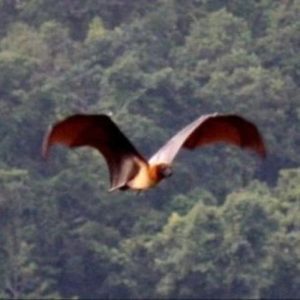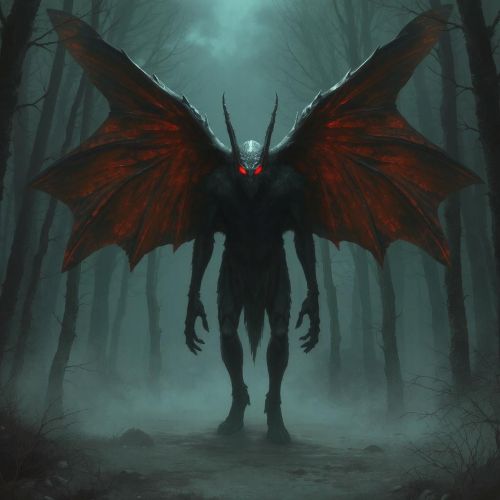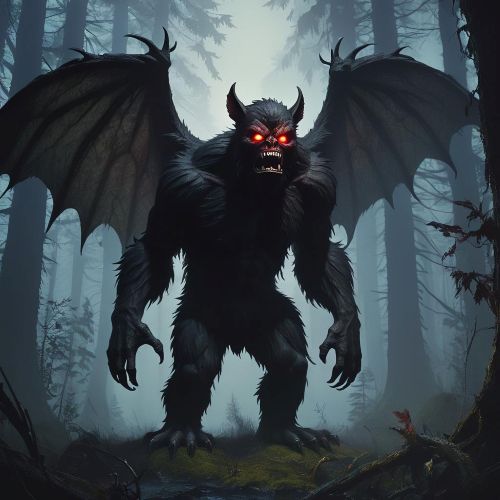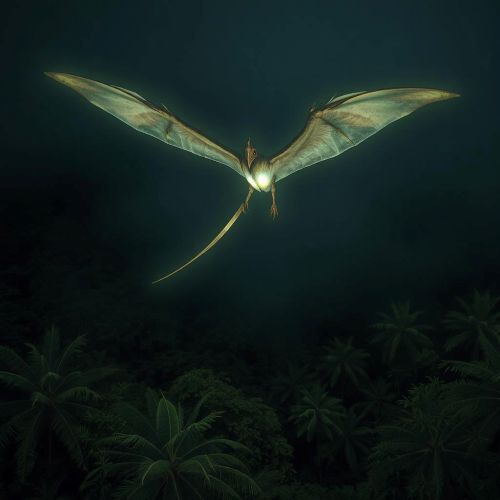Orang Bati : The Winged Terror of Seram Island
| Description | |
|---|---|
| Origin | Indonesia |
| Classification | Cryptid |
| Demeanour | Evil |
| Habitat | Rural Areas |
| Status | Not Proved |

Introduction
The Orang Bati is one of Indonesia’s most unsettling mythological beings, deeply rooted in the folklore of Seram Island in the Maluku archipelago. Described as a night-flying humanoid with bat-like features, the creature has long been feared by villagers who believe it preys on children and wanders through the dense forest after dark. The name itself translates to “man with wings,” reflecting the terrifying image locals hold of this aerial predator. The legend has endured for centuries, surviving through oral tradition, missionary reports, and cryptozoological speculation. Its influence remains palpable today, where even speaking its name casually is considered taboo, believed to attract misfortune or unwanted attention from the spirit world.
Physical Attributes
Folklore consistently describes the Orang Bati as an intimidating fusion of primate and bat, standing roughly five feet tall with a muscular, humanoid upper body. It is said to possess leathery wings that allow it to glide across the night sky, often silhouetted against the moonlight as it searches for prey. Its skin is most commonly described as blood-red or dark crimson, while its wings may be black or dark brown, reminiscent of large fruit bats native to the region. The creature’s long, thin tail and sharp claws add to its menacing appearance, and eyewitness stories often reference glowing red eyes visible in the jungle darkness. Villagers claim it emits a haunting wail—part scream, part cry—which signals its approach and sends entire communities into hiding.
First Sighting/Reporting
The earliest known references to creatures resembling the Orang Bati date back to the 16th century, when local tribes first shared stories with early European missionaries arriving in Maluku. These missionaries documented accounts of a winged being that descended on villages at night to abduct children, a theme that appears frequently in Seram’s oral traditions. One of the most publicized modern claims came from an English missionary, often identified in folklore as Tyson Hughes, who lived on Seram Island in the late 20th century. Initially skeptical, he reportedly witnessed a flying humanoid during his time working with rural communities. Earlier still, researchers have linked similar winged-cryptid mentions to naturalists like Dr. Ernest Bartels in the early 1900s, showing the story’s persistence across decades. Although none of these accounts were accompanied by physical evidence, each helped solidify the Orang Bati as a prominent figure in Indonesian cryptid lore.
Other Names
While “Orang Bati” is its most widely recognized name in Seram Island mythology, the creature is often compared to other winged beings across Southeast Asia. In Java, the Ahool—an enormous bat-like creature—is sometimes discussed alongside the Orang Bati due to shared traits such as size, nocturnal behavior, and a terrifying cry. In Papua New Guinea, stories of the Ropen describe a large flying creature believed to haunt isolated valleys and caves, making it another regional parallel. Within local communities, the Orang Bati may also be referred to as the “flying demon” or “bat man,” depending on the storyteller and the spiritual context. These variations highlight a broader pattern across the region’s folklore: the recurring fear of powerful, winged predators that rule the night.
Modus Operandi
Stories about the Orang Bati consistently depict it as a nocturnal predator whose presence brings fear and panic. According to Seram folklore, the creature emerges only after sunset, gliding silently over treetops and ridgelines as it searches for vulnerable targets. Its most infamous behavior is the kidnapping of children, whom it is believed to carry away to mountain caves for consumption. Many legends place its lair inside the ancient volcanic formations of Mount Kairatu, a remote, cavernous region where the Orang Bati is said to rest during daylight hours. Some villagers describe hearing heavy wingbeats outside their homes at night, while others claim the creature can move with such stealth that only its shrill cry reveals its presence. In some variations of the myth, the Orang Bati is said to possess supernatural abilities—such as briefly vanishing from sight or shifting between animalistic forms—making it even more feared and difficult to comprehend.
Pop Culture References
Although the Orang Bati is not as widely known internationally as other cryptids, it has slowly made its way into niche areas of pop culture. Enthusiasts of cryptozoology frequently discuss it alongside creatures like the Mothman and the Jersey Devil, drawing parallels between their flying humanoid characteristics. The Orang Bati has appeared in online encyclopedias of mythical beings, independent folklore documentaries, and fictional horror stories written by Southeast Asian creators. In gaming communities, homebrew modules for tabletop games such as Dungeons & Dragons have featured the creature, complete with custom stats and lore. Its presence in Indonesian digital media—especially on YouTube channels discussing folklore—has also kept the legend alive among younger audiences who are rediscovering traditional myths.
Current Status
Today, the Orang Bati remains a powerful symbol in Seram’s cultural landscape. While most modern scholars consider it a myth rooted in regional anxieties and environmental dangers, many locals continue to treat it as a real entity. Some researchers have suggested that sightings may be misidentifications of large flying fox bats, which can reach impressive wingspans and are known to inhabit the region’s forests. Others argue that the legend reflects deeper cultural beliefs about spirits and non-human beings that share the land with humans. The creature also appears in discussions about environmental preservation on Seram Island, as deforestation and commercial exploration threaten both wildlife and sacred sites. Regardless of scientific skepticism, the Orang Bati’s role in local identity and spiritual caution remains strong, ensuring that this winged figure continues to loom large in Indonesian mythology.
Source
Okezone. (2021, December 24). Legenda Orang Bati, Manusia Kelelawar Misterius yang Sangat Mengerikan. https://women.okezone.com/read/2021/12/25/406/2522550/legenda-orang-bati-manusia-kelelawar-misterius-yang-sangat-mengerikan
Wikipedia. (2003, May 5). Orang Pendek. https://en.wikipedia.org/wiki/Orang_Pendek
Hilokal. (2024, July 7). Indonesian urban legends. https://www.hilokal.com/lessons/indonesian-urban-legends
Cryptid Wiki. (n.d.). Orang Bati. Retrieved November 19, 2025, from https://cryptidz.fandom.com/wiki/Orang_Bati
Indonesia Sentinel. (2024, August 29). The haunting legends of the Bati Tribe in Indonesia. Retrieved from https://indonesiasentinel.com/the-haunting-legends-of-the-bati-tribe-in-indonesia/
Fun Facts and Trivia. (2025, March 31). The Orang Bati – Shadows Over Seram Island. Retrieved from https://funfactsandtrivia.com/the-orang-bati-shadows-over-seram-island/
National Cryptid Society. (n.d.). Orang Bati: Indonesia’s flying humanoid. Retrieved from https://nationalcryptidsociety.org/orang-bati-indonesia
Paranormal World. (2023). Cryptids of Southeast Asia. Retrieved from https://paranormalworld.net/cryptids-southeast-asia
Mythical Creatures Guide. (n.d.). Orang Bati. Retrieved from https://mythicalcreaturesguide.com/orang-bati
Southeast Asia Folklore Archive. (n.d.). Seram Island legends. Retrieved from https://seafolklorearchive.org/seram-legends
Frequently Asked Questions
Is the Orang Bati a myth or a real creature?
The Orang Bati is widely regarded as a myth, rooted in centuries-old folklore from Seram Island. However, local communities strongly believe in its existence and treat the creature as a real nocturnal threat.
Where is the Orang Bati said to live?
According to tradition, the creature inhabits volcanic caves and remote cliffs around Mount Kairatu in Seram. These isolated, rugged landscapes are believed to offer perfect hiding places for a winged nocturnal predator.
What does the Orang Bati look like?
Folklore describes it as a red-skinned humanoid with large leathery bat wings, claws, glowing eyes, and a long tail. Its combination of primate-like features and bat anatomy makes it one of Indonesia’s most feared cryptids.
Why does the Orang Bati abduct children in myths?
Legends say it targets young children, carrying them away to its mountain lairs to be eaten. These stories often serve as cautionary tales to warn villagers about the dangers of wandering out at night.
Is the Orang Bati related to the Ahool or Ropen?
The Orang Bati shares many similarities with the Ahool of Java and the Ropen of Papua New Guinea, including nocturnal flight and frightening cries. While not the same creature, they form part of a broader Southeast Asian tradition of winged humanoid cryptids.









